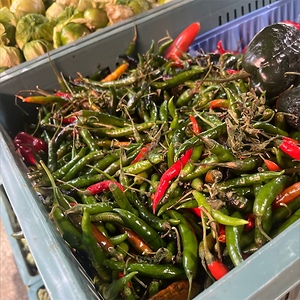


Green Arbol Chile Peppers
Estimated Inventory, 10 lbs : 0
Description/Taste
Green Arbol chile peppers are elongated and slender, averaging 5 to 8 centimeters in length and one centimeter in diameter, and have a slightly curved, cylindrical, and tapered shape with a woody green-brown stem. The bean-like pods are smooth, shiny, firm, and immature as indicated by their dark green skin. Underneath the surface, the thin flesh is crisp, aqueous, and pale green to white, encasing many small and round cream-colored seeds attached to nearly translucent white ribs. Green Arbol chile peppers are crunchy and have a grassy, nutty, and smoky flavor with moderate to hot levels of spice.
Seasons/Availability
Green Arbol chile peppers are available year-round, with a peak season in the summer through early fall.
Current Facts
Green Arbol chile peppers, botanically classified as Capsicum annuum, are the young, immature pods of the famous spicy heirloom red pepper and are members of the Solanaceae or nightshade family. Also known as Chile de Arbol, Pico de Pajaro or “bird’s beak,” and Cola de Rata which means “rat’s tail,” Green Arbol chile peppers get their name from their woody stems and the tree-like bush that they grow on. The immature pods have a milder flavor than the mature red arbol chile peppers and tend to be found on the lower end of the pepper’s Scoville scale range of 15,000-30,000 SHU. Green Arbol chile peppers are rare to find fresh in markets in comparison to its mature counterpart and are heavily used as a flavoring in Mexican, Asian, and Southeast Asian cuisine.
Nutritional Value
Green Arbol chile peppers are an excellent source of vitamin A, which can help protect the eyes from vision loss, and contain high amounts of capsaicin, which is a compound that gives the pepper its sensation of heat and is believed to provide anti-inflammatory and anti-bacterial properties. The pepper also contains vitamins C and B6, riboflavin, thiamin, copper, iron, manganese, potassium, and fiber.
Applications
Green Arbol chile peppers are primarily used raw as a bright, grassy, and less spicy pepper than its mature counterpart in sauces, salads, and cooked dishes. The peppers are an iconic ingredient in Mexican cooking and can be chopped and crushed with tomatillos for chile verde, combined with other peppers for fresh salsas, or blended into hot sauces. The peppers are also popularly used in curries and are heavily used in Southeast Asian cuisine. In addition to fresh preparations, Green Arbol chile peppers can be stewed, sautéed, or stir-fried with other vegetables as a spicy, crunchy side dish, blended into soups or stews, or roasted and grilled whole as a garnish for meats or tacos. The peppers can also be battered and fried as an appetizer or are known for their ability to infuse flavor and spice into oils, sauces, juices, and cocktails. Green Arbol chile peppers pair well with mango, lime juice, tomatoes, tomatillos, garlic, onion, and mezcal. The peppers will keep up to one week when loosely stored whole and unwashed in a plastic bag in the refrigerator.
Ethnic/Cultural Info
Chile peppers are one of the prized culinary ingredients in Mexican gastronomy and are being used to create food tourism experiences for both locals and tourists. In the Mercado Jamaica, which is one of the oldest markets in Mexico City, there is a chile store that hosts a workshop centered around the importance of chiles in Mexico. Known as La Flor de Jamaica, the workshop is hosted by chile expert Fernando Davila in an effort to educate consumers, increase the use of different chiles, and prevent varieties from becoming extinct. There are currently sixty-five different fresh chiles found in Mexico, and of those sixty-five cultivars, sixteen types have become endangered. The chile de arbol is one of the primary chiles discussed and is considered to be one of the most important chiles in the cuisine of Jalisco, Mexico. In the workshop, chiles de arbol are examined for their flavor and are distinguished in shape and spice depending on whether they are grown in Jamaica, China, or Mexico. In addition to the workshop, there is also a tour known as La Ruta del Chile or The Path of the Chile in Mexico that allows visitors to see where chiles are grown and processed. The tour includes a history of peppers such as the chile de arbol, food samplings, and drink pairings with the various pepper flavors.
Geography/History
Green Arbol chile peppers are native to the regions of Jalisco, Chihuahua, and Oaxaca in Mexico and have been cultivated for hundreds of years. The pepper was first documented in the 16th century by Francisco Hernandez, a Spanish naturalist sent to the New World by the king of Spain to study the plants of Mexico. The seeds of the plant were also introduced into Southeast Asia and later the United States through trade expeditions. Today Green Arbol chile peppers are grown in the regions of Zacatecas, Nayarit, Jalisco, Oaxaca, Chihuahua, and Sinaloa in Mexico and are found at local markets in fresh, dried, and powdered form. The peppers can also be found around the world thriving in warm, frost-free climates, especially in New Mexico, and are being commercially cultivated in regions of Asia such as China and in Southeast Asia.
Recipe Ideas
Recipes that include Green Arbol Chile Peppers. One
| California Avocado |
|
California Avocado Deviled Eggs with Chile de Arbol Salsa |
| Rick Bayless |
|
Toasted Arbol Chile Salsa |
| Pati Jinich |
|
Green Beans with Peanuts and Chile de Arbol |









